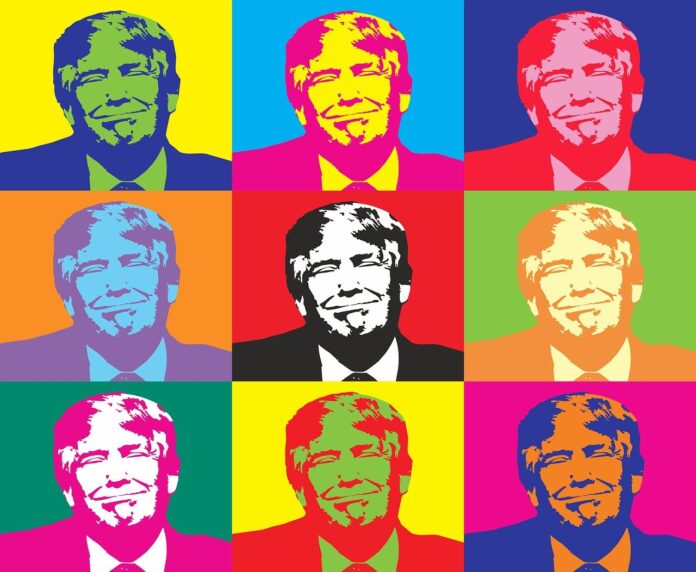By Belgian MEP Johan Van Overtveldt (Belgian Finance Minister between 2014 and 2018, Chairman of the European Parliament’s Budget Committee)
April 1 is the day for jokes. April 2 can from now on be labelled as Liberation Day for the forces of inflation and recession. On that fateful day, Donald Trump substantially increased the probability of a 21st century repetition of the 1930s Great Depression. The remarkable trade tariff initiatives of the American president are based on a revolutionary new school of economic thought that can best be referred to as “Wackonomics”.
Unless one has lived on Mars or Venus for the past few weeks, one must be aware of president Donald Trump’s frontal attack on the free trade order that has brought humankind enormous benefits since the end of the Second World War. A barrage of tariffs imposed on exports from all over the world to the United States will bring, so a triumphant Donald Trump declared on April 2 or in his parlance Liberation Day, investments, jobs and increased welfare to the American citizenry.
The untold story of how Trump shocked Europe in a few short days https://t.co/2sgqbGPIxb
— POLITICOEurope (@POLITICOEurope) April 16, 2025
A cursory reading of history, together with a basic grasp of the elementary principles of political economy, learns that this triumphalism is totally misplaced. Tariffs on imports of the magnitude announced by Donald Trump will beyond any doubt lead to retaliation by most of those hit by those tariffs (which basically means the rest of the world). As we most painfully learned with the Great Depression of the 1930s such an escalating trade war destabilizes the economic and financial system in a fundamental way and augments the risks of political chaos considerably. In the present circumstances, a world wide trade war will not only fuel the forces of recession (or worse) but also of inflation. Double up, on the downside. The Economist was, as usual, very much to the point by redefining Liberation Day as Ruination Day. To avoid such bleak scenarios it is imperative that rest of the world keeps its cool (cfr infra).
It is more than a pity that the tariff assault launched by Donald Trump is based on a total denial of basic economic knowledge, hence my reference to all of this as Wackonomics (wacko being, according to the Oxford Language dictionary, a combination of madness and insanity). Let me be very straightforward : we are not dealing here with ideologically inspired differences of opinion on a policy issue like trade tariffs. No, not at all. We are dealing with denial of an economic identity that holds always and everywhere, whatever your ideology. Let me explain.
Ruination day: How to limit global damage. https://t.co/xwyr1XP55z pic.twitter.com/yqrHD1RnMg
— Jean Verschure (@jeanverschure) April 4, 2025
A look at GDP
The starting point here is the definition of “Gross Domestic Product” (GDP). GDP represents the value of all the goods and services produced in an economy in a year and can be further defined in three ways: the total of net final sales, the total added value created and the streams of income generated in the economy. Taking the first perspective produces per definition the following equation
Y = C + I + G + (X – M) (1)
where Y stands for final net sales (GDP), C for final sales of consumption goods and services, I for final sales of investment goods (and additions to inventories), G for final sales to the government expenditures, X for sales to the rest of the world (total exports) and M for sales of imported goods and services. These imports represent a leak of domestic income and hence have to be deduced. (X – M) represents the trade balance, the most important part of the current account of the balance of payments of a country.
In modern-day international economic statistics, (X – M) catches the full current account of a country’s balance of payments which contains all the transactions between a country and the rest of the world. The other part of the balance of payments is the capital account. Since the balance of payments needs per definition to be “in balance”, a deficit on the current account necessitates an equivalent surplus on the capital account, meaning that the country with a deficit on the current account will need to have import of capital (whether spontaneously or induced through government intervention). Countries showing a surplus on the current account will per definition be exporters of capital.
The third way to define GDP (or Y) is the “streams of income” – approach. The incomes generated within the economy can be used in three ways. They can be consumed (C), saved (S) or paid in taxes (net of transfers made by the authorities to its citizens), usually represented by the symbol T. Hence:
Y= C + S + T (2)
Given (1) and (2) it can of course be written that
C + I + G + (X – M) = C + S + T (3)
Some simple mathematical manipulation of equation (3) leads to the following basic macroeconomic identity:
(S – I) + (T – G) = (X – M) (4)
Identity (4) shows that the position of the current account (deficit, surplus or in equilibrium) is linked to the domestic private savings (S), private investments (I) and the government’s budgetary balance (T – G). A word of caution here: equation (4) is an identity that tells us not much about causation. Nevertheless, from a policy point of view important insights and conclusions can be drawn from this basic macroeconomic identity.
The accompanying table shows the data oo the composing parts of equation (4) for the United States and a few other countries in 2023. The US had a current account deficit equal to 3.3% of GDP. The private saving surplus (S – I) amounted to 4,3% of GDP but was insufficient to cover the government budget deficit equal to 7.6% of GDP. Hence there was a massive capital import as counterpart of the deficit on the current account. China shows a government budget deficit very close to the one of the United States, i.e. 7.4% of GDP. However, in China the private saving surplus is more than the double the one of the US and more than covers the budget deficit. Hence, a current account surplus and capital export. Germany has a private saving surplus very close to the Chinese one and a much smaller government deficit (2.2% of GDP). Hence a huge current account surplus (6.2% of GDP) and massive capital export. The Netherlands are even more extreme: an enormous private savings surplus, practically no government deficit and hence a monstrous current account surplus.
Important meetings taking place today.
Meloni is meeting Trump in the U.S. to discuss EU-U.S. trade relations.
Witkoff and Rubio are in Paris to discuss Ukraine with European leaders, including Macron. pic.twitter.com/Ydrrkmqc3N
— Visegrád 24 (@visegrad24) April 17, 2025
Besides the point
President Trump has hardly given one speech in which he didn’t engaged in a rage on the persistent current account deficit of the US. It is indeed true that the US is already for decades running a current account deficit. Here, the causation issue raises its head. Is that current account deficit the result of persistent budget deficits and insufficient private savings or is it the other way round? The fact is that foreigners in the past have been eager to invest in US assets for several reasons such as the dominance of the dollar in international trade and finance, the growth performance of the American economy, the depth and liquidity of American financial markets and the rule of law in the US. So capital imports necessitated a current account deficit and allowed the US government to run almost systematic budget deficits, given the limited net savings generated by the American private sector. This situation has since the 1960s time and again be referred to as the “exorbitant privilege” of the United States.
Where all this becomes Wackonomics is where one starts arguing that tariffs on the trade partners will cure the current account deficit. They will only do so if and when they lead to a reduction in the internal spending in the US. Translated to the scheme developed above, tariffs will have to lead to higher internal private savings and/or a much lower government budget deficit. Higher internal net savings means higher saving ratios and/or lower investment, hence recession. A smaller budget deficit would of course also contribute much to the reduction of the current account deficit but Donald Trump is pursuing policies which in the coming five years will systematically further increase the budget deficit. It is, by the way, becoming increasingly clear that Elon Musk, hailed as Trump’s deus ex machina to improve massively efficiency within the American government bureaucracy, is not really succeeding in this task, even on the contrary. Trump totally ignores the most logic measure available to him that would lead to a guaranteed reduction of the so hated current account deficit, being a substantial reduction of the American government budget deficit.
Hence Wackonomics: there is no way that tariffs will reduce the American current account deficit given the other policy options pursued by the Trump administration. For one thing, the massive import tariffs Trump is installing will drive up American prices too and hence handicap the competitiveness and export capabilities of American companies. Of course, the recession and inflation outburst that will follow the trade war that is now set in motion can lead to such dramatic changes in patterns of savings, investment and government deficits in the US and elsewhere that current account balances also will change. The direction of such changes is impossible to predict at this time but what can be predicted with great certainty is that such adjustments will work themselves out in world that is not only in political turmoil but also in deep economic and social crisis. “The global economy”, so Mohamed El-Erian, president of Cambridge’s Queens College and chief economic advisor at insurance group Allianz, concluded, “is on an bumpy road to an unknown destination”.
The Editorial Board of the Financial Times summarized it all succinctly by defining Trump’s reciprocal tariffs assault on the rest of the world as “one of the greatest acts of self-harm in American history. They will wreak untold damage on households, businesses and financial markets across the world, upending a global economic order that America benefited from and helped to create”.
Trump doet er echt alles aan om de VS en de dollar als centrale elementen van het internationale financiële systeem onderuit te halen. https://t.co/7HOrEEnf7Y
— Johan Van Overtveldt (@jvanovertveldt) April 13, 2025
It doesn’t stop here
Is using tariffs and a trade war to eliminate a current account deficit the only chapter in the Wackonomics manual? Unfortunately it isn’t. The way in which the specific tariffs for the different countries and regions were calculated constitutes another chapter in this manual. I won’t dig in deeper into this subject, since others have done the job here already well enough. The bottom line of it all is that the methodology used to calculate the different tariffs is deeply flawed and does not make any economic sense at all.
A third chapter in the Wackonomics manual consists of a theme that is still under discussion within the Trump administration. If translated into policy reality, it risks becoming even more destabilizing than the tariff craze. This third chapter in the Wackonomics manual is focused on the US Treasuries market, the bedrock of the international financial system. Treasury Secretary Scott Bessent and even more Stephen Miran, chairman of the Council of Economic Advisors in the Trump White House, are the cheerleaders for this third chapter.
Their line of argument starts with the thesis that the dollar is persistently overvalued and hence a drag on the competitiveness of the American corporate sector. Dollar overvaluation is the result of foreigners’ eagerness to buy US assets, especially US Treasuries. To cure this situation considered hugely unfair towards the United States, so Bessent and Miran’s thinking goes, foreign investors would need to be managed more forcefully in the direction of serving America’s interest. Hence the idea to tax foreign investors buying US treasuries in combination with pressuring with whatever means available foreign holders of US Treasuries to get into perpetual dollar bonds. What all this is supposed to lead to is the combination of on the one hand a lower dollar exchange rate and on the other hand holding on to sufficient foreign capital inflow into the United States to allow Washington to keep running considerable budget deficits.
The above reasoning and consequent policy proposals truly deserve to be described as Wackonomics. As outlined above, the US is as dependent on foreign capital flowing into the US as foreigners are eager to come to the deep and liquid American financial markets. The volatile and counterproductive policies of the Trump administration, not to mention the attempts of that same administration to undermine rule of law, are rapidly undermining this attractiveness of dollar assets. For the time being investors still flee in large numbers to the US Treasuries market (as did in the hours after Trump’s tariff assault) but more and more question are asked.
The Bessent-Marin thinking will undoubtedly seriously disturb the US Treasury market and hence also the entire financial system. One thing is for sure: that disturbance will push up interest rates, in the US and most probably also worldwide. Further consequences are harder to predict in precise ways but good news is not present in any scenario that can be taken under consideration. As one international banker told me: “If these proposals are pushed through, we enter in a very dark room”.
3/At the same time as the dollar has depreciated, US Treasury bonds, the bedrock of the global dollar financial system, have sold off as global investors have questioned the safety of Treasurys. Figure 2 plots the spread between the yield on 1-year synthetic Treasurys—constructed… pic.twitter.com/OjwZ9SR7mX
— Hanno Lustig (@HannoLustig) April 16, 2025
How to react to the Trump tariffs
Realizing that the economic policies emanating from the Trump White can only be described as being grounded on Wackonomics is one thing, but the other and more important thing is of course how policymakers outside the United States should react to it all. Focusing on the tariff assault launched on the rest of the world, it seems rather obvious to me that we Europeans should engage in damage control. A full-scale trade war is certainly not in our economic, social and political interest. So immediate and substantive retaliation, as the Chinese government did, is not the most sensible reaction. Much more interesting and productive is the “we take note” – style reaction of Switzerland.
Our reaction should take fully into account that it is rather obvious that the tariff assault is mostly a typical negotiation tactic used by Trump all the time: shock your adversaries and partners with wild actions and declarations so that they are intimidated when they come to the negotiating table. It is indeed the purpose of the Trump modus operandi to use the tariff craze as a negotiating chip to be played with in order to achieve results that have more to do with power and security than with … tariffs. Also, one should never forget that Trump is a transactional man, focused on doing profitable deals. Highly indicative of this Trumpian approach is his reaction to China’s immediate retaliatory action. “China played it wrong – they panicked!”, so Trump wrote on his social media platform.
We need to reflect carefully on what can be offered to Trump in this transactional context and try to make sure that such offers are to the benefit of all concerned and inspire the American president to walk back on, for example, tariffs.
Book Summary: “Trump: The Art of the Deal”
tap, hold, load 4k pic.twitter.com/LXOBXSDtda
— MindBranches (@MindBranches) April 9, 2025
Disclaimer: www.BrusselsReport.eu will under no circumstance be held legally responsible or liable for the content of any article appearing on the website, as only the author of an article is legally responsible for that, also in accordance with the terms of use.













